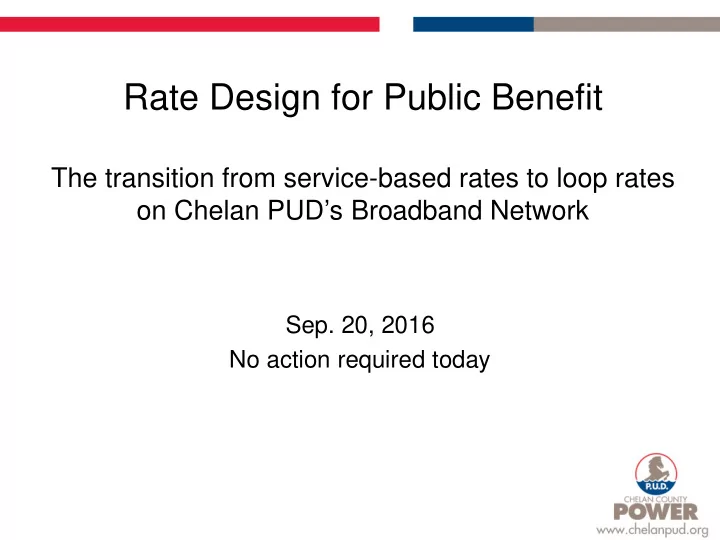

Rate Design for Public Benefit The transition from service-based rates to loop rates on Chelan PUD’s Broadband Network Sep. 20, 2016 No action required today
Philosophy • Simplify rates and align costs with drivers by charging based on Broadband usage • Provide an incentive to Service Providers to reach more homes and businesses than today • Support revenue at current levels and grow revenue as usage requires additional investment 2
Background • 2012 Strategic Plan for Fiber – Recommended better alignment of cost with providers Complete: Board action June 2012 – Recommended rate increases Complete: Board action June 2012 and March 2014 – Recommended selling Video Head End Complete: Board action August 2015 – Recommended transition to Loop Rates 3
What is a loop? • Definition of a loop – Local Loop – Digital Local Loop (DLL) – Wireless Local Loop • Why it has significance in the Telecom world 4
Designing Loop Rates • What has changed since the original recommendation – PUD has increased overall rates to Service Providers – We are seeing big growth in customer demand for broadband. 6
Demand for Broadband • Cisco predicts that U.S. broadband demand will double in the next four years. • Future demand for more broadband in the next few years driven by: – More online video and larger video files (4K and 8K video) – Virtual reality and advanced gaming – Machine-to-machine broadband (Internet of Things, cloud storage and cloud applications) – More working from home – Monitoring (security cameras and health monitoring) – The start of “telepresence” *Telepresence refers to a set of technologies which allow a person to feel as if they were present or to have an effect via telerobotics at a place other 7 than their true location
Demand for Broadband • “Busy-hour” demand growing much faster than overall demand. Busy-hour traffic is now doubling every two years. This puts a huge strain on networks to satisfy speeds for prime-time video. • Cisco predicts video traffic will be 82 percent of residential traffic by 2020. Much of this video is going to come from cellphones (but will still use landline WiFi networks). • Cisco predicts by 2020 that average household will want 47 Mbps download (up from 24 Mbps today). 8
Rate Design • Revenue recovery is based on two parts: – Fixed loop rate – Measured usage rate 9
An Example • 100 Mbps Digital Local Loop – Monthly rate $12.00 – Aggregated Bandwidth Rate $0.12/GB • 1 Gigabit Digital Local Loop – Monthly Rate $15.00 – Aggregated Bandwidth Rate $0.12/GB Rates and Bandwidth Charges were designed to be revenue neutral to +.5% based on current usage history. *Mbps = Megabits per second (Speed) GB = Gigabyte (Capacity) 10
Benefits of the Proposed Rates • Rate design provides an incentive to Service Providers to bring service to more homes and businesses. (Can profitably afford to provide only one or two services) • Allows Service Providers to treat transport services as a cost center • Better structure their prices and services offerings • Create branding, marketing and sales strategies • Reduces dependencies on PUD pricing decisions • Directly aligns service provider rates to the costs incurred by the PUD • Something the service providers will like - as bandwidth usage increases over time, the cost of bandwidth per gigabit should drop (means periodic review of rates) 11
Other Changes to Wholesale Rates • Technology standard updates to Virtual Local Area Network (VLAN): advanced services • Lower VLAN rates to competitive market levels • 10% Increase on Dark Fiber rates • Introduce new Fiber services (Wave Division Multiplexing - Lamda Services) as a price competitive alternative to Dark Fiber • Add one time Nonrecurring Charge (NRC) for provisioning Quality of Service (QoS) for IP-TV and Voice over Internet Protocol (VoIP) * Wave Division Multiplexing (WDM) is a technology which multiplexes a number of optical carrier signals onto a single optical fiber by using different wavelengths (i.e., colors) of laser light. 12
Other Changes to Wholesale Rates • Introduce a new rate for IP-TV • Plain Old Telephone Service (POTS) rates will be reduced • Include Non-recurring Fees and Charges schedule with Rate Schedule for clarity 13
Next Steps • Presentation with detailed rate structure and draft resolution presented on Oct. 3 (no action requested) • Resolution presented for Board approval on Oct. 17 • If approved, rates, fees and charges will be effective Jan. 1, 2017 Questions? 14
Recommend
More recommend